
Tips for every room
Avoiding bending down
- Attach a basket to the inside of your letter box.
- Move electrical sockets higher up the wall with an extension cable or by getting them rewired.
- Make sure you can easily reach items when you store them.
- Try using a reaching stick, or pick-up stick.
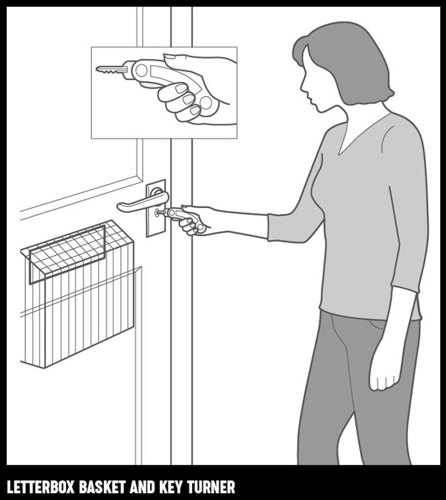
Making switches, dials and plugs easier to grip
- Large rocker, pull-cord or touch operated light switches are easier to use.
- Electric or gas fires are easier to turn on if the control knob is on the top.
- A contour grip will help if you have difficulty turning dials or knobs.
- Built-up key handles can help with inserting and turning the key in the lock.
- Wrapping an elastic band around rounded door handles can make them easier to open.
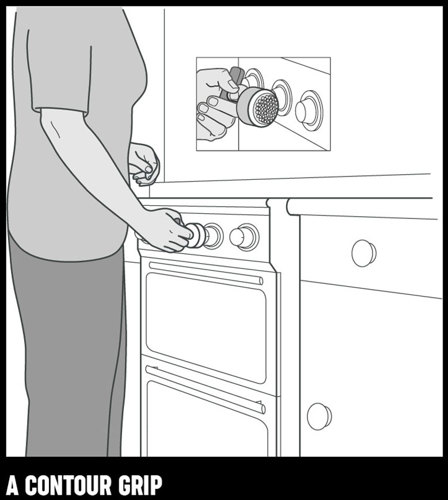
Avoiding trips and falls
- Remove any loose mats or carpets.
- Make sure your stairs, hall and landing are well lit.
- Make sure you have enough space to get between or around your furniture.
- Fix a second banister on the stairs and a grab rail by the front door.
Your kitchen
Top tips
To make cooking easier, it might help you to:
- use joint protection techniques when you're moving pots and pans
- use suitable equipment or special gadgets to help you
- redesign or reorder the space in your kitchen
- think about how you arrange cupboards and work surfaces to make items easier to reach
- raise your washing-up bowl by putting it on blocks or another upturned bowl in the sink.
Gadgets and tools
Preparing food can be hard if you find it difficult to grip things. This picture shows some gadgets that can help.
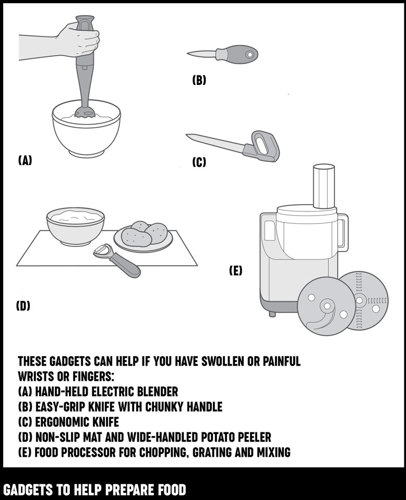
There are also many gadgets on the market for opening bottles, jars or tins, so try before you buy. You can see some on the following illustration.
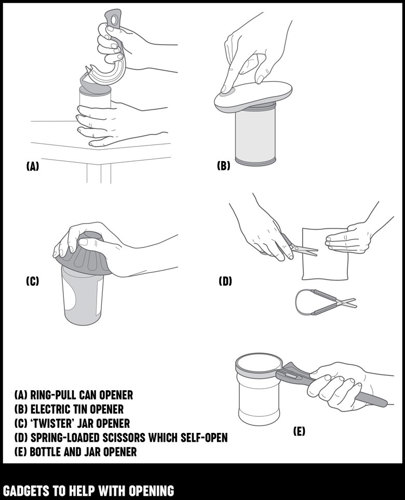
Cooking
Most supermarkets sell ready-prepared food such as chopped vegetables, grated cheese and roasted potatoes. Have some pre-prepared ingredients and ready-made meals in the freezer to avoid struggling when your arthritis is particularly troublesome.
The following should help you reduce strain on painful hands and wrists when cooking:
- Use a lightweight, two-handled saucepan.
- Use a vegetable steamer – they can be lighter than a saucepan because they don't need as much water.
- A table-top cooker can be easier to use than a casserole dish that you place in the oven.
- Cook vegetables in a wire chip basket, placed in a saucepan so it's easier to lift them out when cooked.
- Make wooden spoons, knives and other handles bigger by adding some foam tubing (pipe lagging).
Serving food
- Remove vegetables from the saucepan or steamer with a slotted spoon. Use a flat-bottomed ladle to remove soups and stews.
- Think about using a trolley to take plates to and from the table. Use lightweight crockery and cups with large handles that you can grip with several fingers.
- Insulated or pedestal mugs can be held with both hands because you can support them underneath without burning yourself.
Choosing kitchen equipment
If you're buying new equipment, shop around to make sure what you’re buying is easy to use and maintain. Ask yourself the following when choosing:
- Are control knobs easy to reach, grip and turn, push or pull?
- Can I open the doors of electrical appliances?
- Will I be able to clean and maintain equipment easily?
- Can I lift/move appliances easily if I need to?
Using kettles
Electric jug kettles are generally easier to grip and pour from than traditional kettles.
Cordless kettles with a central round power socket to fit onto are easiest, or you could use a lightweight travel model instead. Look for non-slip handles and good balance when lifting. You may find a kettle tipper helpful.
Bring water to the kettle in a lightweight plastic jug to avoid having to unplug or move the kettle. Or think about installing a table-top water boiler so you don’t have to keep refilling a kettle. Fast-boil hot-water dispensers are also available.
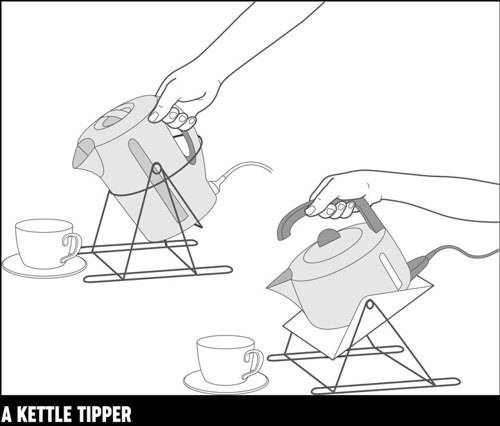
You may also find lever taps are easier to use than regular taps. You can buy these, or fit tap turners onto existing taps.
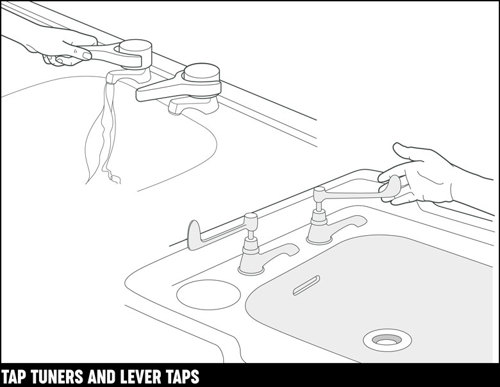
Work surface and cupboards
To make it easier to use the work surfaces and cupboards in your kitchen, try the following:
- Find the work surface in your kitchen at which you’re most comfortable.
- Avoid standing for long periods.
- Sit at the kitchen table or perch on a high stool.
- If your work surfaces are on the same level with no gaps in between, slide pans and groceries along them to avoid lifting.
Tips for cupboards that are out of reach
Reaching into very low or high cupboards can be hard, particularly if they’re cluttered or stacked several layers deep. The following tips might help:
- Store items you use often within easy reach on the work surface or at the front of cupboards at a convenient height.
- Lower wall-mounted cupboards.
- Fit large handles or sliding doors.
- Have shelves that slide or rotate out when you open the door.
- Have drawers mounted on rollers, which run more easily than standard drawers.
- Use plate shelves, rather than piling crockery up.
- Use step-shelves inside cupboards to easily see and reach jars and tins.
Tips for re-designing your kitchen
If you're redesigning your kitchen or moving house, ask yourself the following when you're looking around:
- Are cupboards the right height for you to reach into?
- Can you open doors and drawers?
- Are surfaces the right height for you to work at?
Your bedroom
Making a bed can be difficult. You may find it helpful to have a lightweight mattress or to use a mattress pad on top of your ordinary mattress, so you only need to lift a thin pad to tuck sheets under. Try fitted sheets and a doona.
Using an extra sheet under your doona will mean you don’t have to change the doona cover as often. Try widening the opening at the base and up the sides of the doona cover, so it’s easier to get the doona in. Some doona covers come with bigger buttons rather than small poppers at the base.
You can also try using pegs to hold the doona in place on the bed to make it easier to pull the cover off.
Being comfortable in bed
Pillows
A comfortable pillow can help reduce neck pain and shoulder pain. Shaped or memory foam pillows can help. Don't prop your pillow too high, as this can put your neck at an uncomfortable angle.
Mattresses
A lightweight mattress or mattress pad might make it easier to change the bedsheets, but you should also think about how comfortable it is and whether it gives you the right support.
Your mattress needs to hold your spine correctly:
- When you lie on your back it should retain its natural 'S' curve.
- When you're on your side, it should be straight. Use a gel pad placed between your knees to reduce knee pain in this position.
For most people with RA, a mattress that conforms to and supports your body to avoid excessive pressure points on your joints is most comfortable.
Lying on an unsupportive mattress can actually cause joint pain. Mattresses have set lifespans, and when that's over they'll sag. These are all signs that your mattress is past its best:
- it's more than 10 years old
- it's sagging or lumpy
- it's gone floppy
- you feel the springs easily.
You may be advised to put a board under a sagging mattress. However, this can actually create painful conditions at the pressure points of your hips and shoulders.
Buying a new mattress
Before you buy a new mattress, do your research so you know what your options are. Go to a good retailer who can discuss the features and benefits of their products.
Don't be shy about trying out beds, particularly in the position you sleep in. Take your partner so you can find a mattress that suits both of you.
You get what you pay for – generally the more you pay the longer the mattress will last and the better quality of support you get. Put comfort and long life before looks.
Many people find memory foam mattresses or toppers helpful. A common recommendation is to buy a firm or orthopaedic mattress. But whether this is right for you depends on factors such as:
- your weight and build
- your age
- the way you sleep
- the sort of aches and pains you have.
A new mattress may help with aches and pains, but it shouldn’t be seen as a substitute for proper medical treatment.
Your bathroom
Washing
Lever taps on the sink and bath are easier to use. Liquid soap in a push-button / push down dispenser is easier than using a bar of soap.
Getting in and out of a bath can be difficult. It isn't a good idea for someone to lift you in and out, as they could easily hurt their back or injure you. The following may help:
- a non-slip bath mat
- a grab rail
- a bath board and seat
- a powered bath seat lift.
Another option is a special walk-in bath, but installing one of these will be expensive.
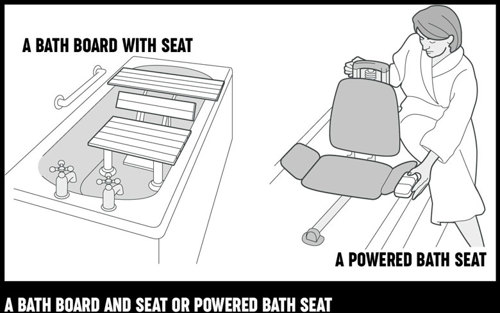
Showering
A grab rail and fold-down wall seat, shower stool or plastic garden chair in the shower will help you to shower comfortably and safely if you have a shower cubicle.
If your shower is over the bath you may find it safer to sit on a bath board (a slatted board placed across the top of the bath).
Large, level-access showers are often cheaper to install than a walk-in bath.
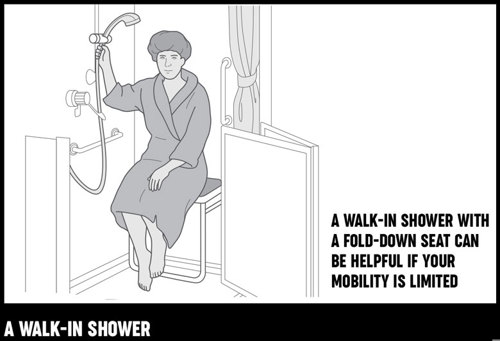
Drying yourself can be difficult if your joints are stiff and painful. Try these tips:
- Put on a thick towelling dressing gown instead of drying yourself with a bath towel.
- Use a microfibre towel – they're much lighter and you don't have to rub yourself. You can buy them from camping and travel shops.
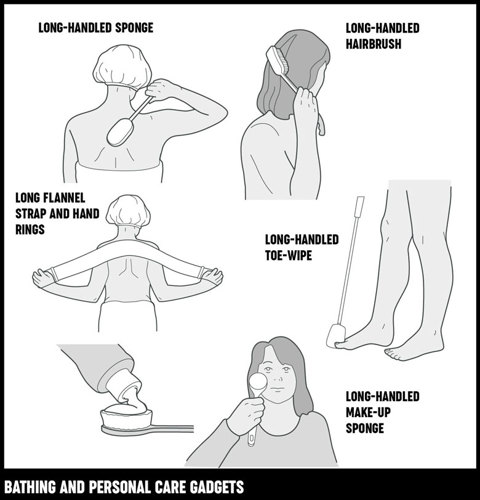
Using the toilet
If your shoulders, hips and knees are stiff or painful, getting up from the toilet and reaching to clean yourself can be difficult. Equipment that can help includes:
- a grab rail beside the toilet
- a raised toilet seat
- a frame surrounding the toilet to push up from
- a bottom-wiping gadget
- a portable bidet which fits onto a standard toilet pan
- an automatic flushing toilet with built-in bidet, which washes and dries you.
Choosing a chair
Having the right chair for you
Is my current chair ok?
Having the right chair is very important for a person who has arthritis. Here are some questions you should think about to make sure you have the right chair:
- Do you find it difficult to get out of your chair?
- Do you have to use cushions to make it comfortable?
- Do you get more aches and pains after you’ve been sitting for a while?
- Does the chair make you slouch?
- Is it too large or too small?
If you answered yes to any of the above, then you should think about getting a chair that’s properly designed for your needs.
How high should my chair be?
Many people think they can only be comfortable in a low chair, but a high chair can be just as comfortable – and probably more so if you have back pain. A higher chair makes getting up much easier, as you're almost half-way up already.
Choose the highest chair you can that allows you to place your bare feet flat on the floor while sitting in it. This will stop your legs from dangling uncomfortably and causing pins and needles. Check that you can get up from it easily.
If you find a chair you like but it's the wrong height, ask the shop assistant about having it altered.
Are armrests important?
Painful joints can make it difficult to use the armrests on a chair. However, using the armrests can be as effective in helping you get up as having a higher chair. Look for:
- a good handgrip – armrests are easier to grip if they're made of wood and stick out a few inches, as this will allow you to wrap your fingers around the end
- padding for comfort and warmth
- the right height – if you have to hunch your shoulders when you rest your arms on the armrests, they're too high, but if your elbows don't reach then they're too low
- the right length – if the armrests stick out too far beyond the front legs it can sometimes tip the chair up when you put your weight on it.
What can help me get up from my chair?
Choose a chair that allows you to tuck your feet back underneath you. This will make it easier to get up because you can bring your weight over your feet more quickly. Check that your chair has space at the front beneath the seat.
If you find it difficult to stand up from a chair, you may find motorised chairs or spring-assisted seats useful:
Motorised chairs
Motorised chairs use an electric mechanism to lift the seat and bring you to a standing position.
Spring-assisted chairs
Spring-assisted seats can be useful but are often uncomfortable. They have to be adjusted to your weight, so you'll need to be careful if other people use it because it may cause an injury if they're much lighter than you.
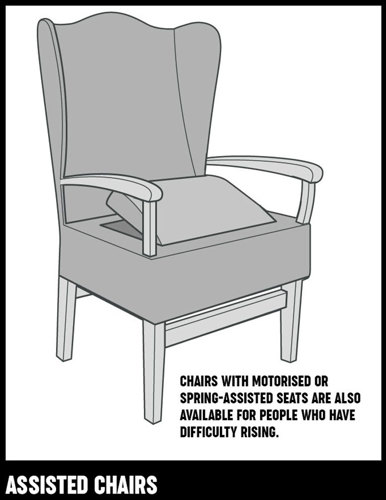
What type of seat covers are best?
If you have difficulty getting to the toilet, think carefully about what type of seat cover would be best suited to you. Although a vinyl covering is waterproof and easy to wipe down, it can cause you to sweat and may become slippery. Removable covers over a waterproof vinyl cushion are more comfortable and convenient as they can be washed whenever needed.
Covers made of wool or washable sheepskin will be soft and warm, and they can absorb a lot of moisture while allowing you to feel dry.
Other chair considerations
Moving the chair
Choosing a lightweight chair may be a good idea if you'll need to move your chair, but it must be strong enough to take the knocks of everyday use.
Function versus fashion
Function is always more important than fashion. But this doesn't mean that your chair needs to look very different. Look around at all the available chairs and try to buy one that blends in with the rest of your furniture – but don't buy one based on this alone.
Suitability
You may have to think about a different style of chair from those you've had in the past in order to find one that suits your needs. But if you think about your needs carefully and try it out properly, you may be surprised at how easy it is to get up from a different kind of chair and how comfortable it is.
Try before you buy
There’s only one rule when finding an easy chair: Try it before you buy it! Sit in the chairs that interest you, don’t be harassed and take your time.
Furniture shops and department stores should have a wide range. There are also specialist warehouses that are used to dealing with people with arthritis or disabilities. These often have showrooms where you’ll be welcome to arrange a visit. Some chair manufacturers will come to your house to talk with you and lend you a chair to trial in your home. However, don’t feel pressured into buying.
Support
It's important to check that the seat and backrest of your chair will give you support and make it easy for you to stand up. There should be enough room for you to easily change position.
Apart from the height and armrests, there are other points worth looking out for when finding a comfortable chair.
The seat
You should look closely at the seat to make sure it'll give you support, comfort and a firm base to push up from. You should think about the following:
- Check the cushion is made from good-quality foam (cheaper foams may go soft and start sagging after a few months).
- Try to avoid seats that sag like a hammock when you sit in them. This can be uncomfortable as you're resting on the base of the seat. It may make it also difficult to get up.
- Avoid narrow seats – there should be enough room for you to easily change position as staying in the same position can be uncomfortable.
- Check that the seat isn't too deep as it may not be good for your back. It may also be difficult to get out again. The seat should be just deep enough to fully support your thighs when you sit as far back as possible.
Backrests
It's important that your back is fully supported. A backrest that's gently sloped to fit the curves of your back is helpful. But everybody's back is different, so it's important to try before you buy. You should think about the following:
- Check that the backrest isn't at an awkward angle. If it slopes too far forward, it'll stop your back muscles relaxing as they'll be forced to keep working to stop you slumping forward. If it slopes too far backwards, it'll make it harder to get up.
- Check that the backrest is high enough to support all of your back, shoulders and head.
- If there's a headrest, make sure it doesn't push your head forward as this will cause neck ache.
- Some people like to use a reclining chair so that they can change their posture easily but remain supported.
Your personal care
Getting dressed
Getting dressed can take longer than normal and can be tiring if your joints are stiff and achey. It's usually easiest to sit down to get dressed, and there are a wide variety of gadgets to help, including:
- a buttonhook for fastening buttons
- long-handled shoehorns
- a dressing stick
- a sock aid.
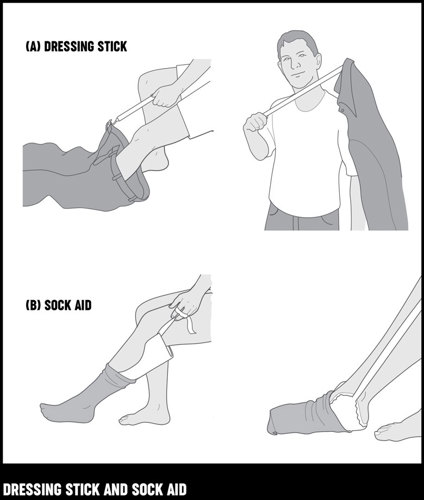
You can adapt clothes by replacing some fastenings with Velcro. Try placing a zip pull tag, small piece of ribbon or key ring on a zip to hook your finger through.
Hair and grooming
Using a hairdryer or straighteners may be easier if you sit at a table and support your elbow on a pillow or cushion. You could also try 'hands-free' hairdryer holders/stands or a portable hairdryer hood attachment so you don't have to hold the dryer as you style.
Use a lightweight electric razor when shaving.
Brushing your teeth
Use an electric toothbrush or fatten up the grip of your toothbrush by wrapping an elastic band around the handle. A toothpaste squeezer can make it a lot less fiddly to clean your teeth.
Make-up
Choose eyeliner pencils and mascara with chunky grips or fatten up the grip by wrapping an elastic band around the handle. You can also try this for toothbrushes and make-up brushes.
Use a small make-up sponge to apply face cream if you find it difficult to do with your fingertips. Mounted it on a long handle to improve reach.
If you have trouble opening child-proof containers, your pharmacist can put them in a more suitable container for you.
DIY and housework
There are many things you can do to make DIY or housework easier and less painful. At all times, think about the position you're in when you're doing activities and try to always maintain a good posture. Using different tools that might make jobs easier is a good idea – for example, you could use tools with long handles so that you don't have to bend down.
DIY
Organise storage in your workshop, potting shed or garage using the same ideas as suggested for the kitchen – worktops should be at a comfortable height and you should sit or 'perch' to work.
Pad the handles of tools to make them easier to grip. Some manufacturers now produce tools with large grips. Look for non-slip, comfortably shaped handles. Lightweight, power-assisted tools such as drills or screwdrivers can also be useful.
Cleaning
Wear wrist splints while polishing, sweeping and doing DIY to ease pain. Use a long-handled dustpan and brush so you don’t have to bend down.
Use a towelling mitt for dusting or cleaning mirrors/windows as it’s easier than gripping a cloth.
Raise your washing-up bowl by putting it on blocks or another upturned bowl in the sink.
Washing and drying clothes
Raise your clothes basket on a block or box to make it easier to pick up or use a clothes basket or plastic box with wheels and a handle if possible. You may find it easier to do half-loads when washing.
A reaching gadget may help to get the clothes out of the machine.
Use a tumble drier – take the clothes out straight away and hang up to reduce creasing (and ironing).
Ironing
If you can, plan ahead and buy non-iron clothes and fabrics.
For small amounts of ironing, use a portable ironing pad or thick towel on a worktop.
Setting up an ironing board to a low level can help with shoulder pain, but it shouldn’t be low enough to make you stoop. It might help to sit down to iron. Use a reflective ironing board cover so you only need to iron clothes on one side.
If you're redesigning your living space, you may want to consider a pull-out ironing board.
An iron-flex holder which keeps the iron's cord out of the way can reduce wrist strain.
Your leisure time
TV and phone
Try the following tips to make using the TV and phone easier:
Using the TV
Use a remote control with large buttons and a modified grip. Some can also be programmed so you can use them on a number of electrical appliances.
Home phones
A cordless phone is easy to grip and handy to keep by you. It will save you getting up when you're relaxing and can also call help in an emergency. Some phones have a hands-free option so you can use the phone without holding it to your ear.
Mobile phones
Use a mobile phone with large buttons. Alternatively, many smart phones have touchscreens that can be used with a stylus to make it easier to type. Pad the stylus end or wrap an elastic band round to make it easier to hold.
Many mobile phones have a loudspeaker option or can be used with a hands-free headset so you don't have to hold them to your ear.
Phone alarm systems
A phone-alarm system has an alarm button which can be kept in a pocket, hung around your neck or pinned to your clothes. When the button is pressed, the phone will call for help.
Using a computer
Sitting at a computer for a long time with poor posture will make aches and pain worse. You should:
- take regular breaks and change your position often
- sit squarely facing the computer with good posture and your back and arms supported
- use a table and chair that allows you to sit comfortably
- keep your mouse close to you – don’t over-reach
- wear wrist splints for support, or try resting your wrists on a sponge bar in front of the keyboard.
You can also get mouse mats with similar cushioning, but you'll need to be careful with these as they can result in overuse of the wrist to keep the mouse on the mat. This can put pressure on your median nerve, which may trigger carpal tunnel syndrome symptoms.
You could also try using voice-activated software – it takes a little while to ‘train’ the software to recognise your voice, but it can make using a computer a lot easier.
Reading and writing
If gripping books or pens makes your hands and wrists painful, these tips may be useful:
- Look for a pen that has a chunky grip which is easy to hold.
- Try resting your book or newspaper in your lap or on a table to avoid straining your fingers.
- Rest a book on a beanbag, lap tray or book rest.
E-readers and tablets
Many books and magazines are available digitally on e-readers or tablet computers. Some models are very light, so they may be easier to hold than a book, and you may be able to buy covers that double as stands so you don’t have to hold them at all.
Certain models also let you borrow e-books from your local library. Check this with the retailer if you’re unsure.
Shopping
You may find shopping is difficult and tiring, but there are ways round this problem:
- Shop online or get home deliveries.
- Plan to shop on a day when you don’t have many other things to do.
- Don’t carry too much in one go. You can also try adapted grips to prevent carrier bags digging into your fingers or use a shopping basket/trolley on wheels.
- Take someone with you to help or ask friends to shop for you.
- Ask for help at the supermarket, especially with packing and loading into the car.
Many large stores provide wheelchairs for customers.
Products to help in the home
Many of the products mentioned in these pages are available from supermarkets, hardware, household and DIY stores, kitchen shops and chemists.
Prices can vary so shop around. You should also try out equipment before buying it to make sure that it’s right for you. You can also visit an Independent Living Centre where items can be tried out and expert advice given.











